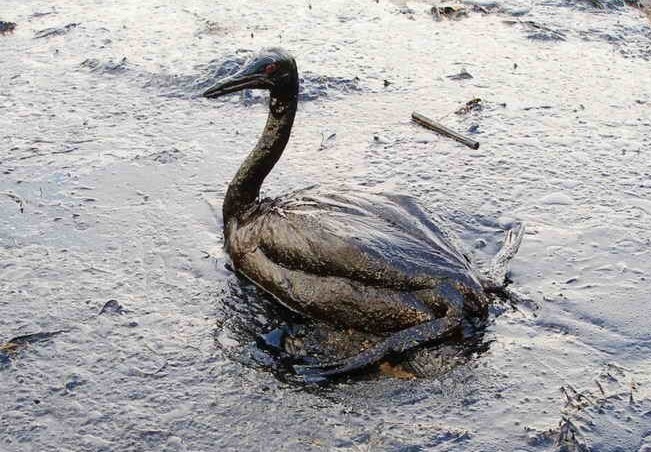
An oiled bird struggles to stay alive. Like many of the statements made by Exxon this week in Montana, this picture has nothing to do with reality on the Yellowstone River, it’s generic. (Photo by Igor Golubenkov/fotopedia)
Like Bill Murray in the movie Groundhog Day, we keep moving through the same sequence of events, disaster after disaster, until it really gets kind of annoying. This is the industry’s Standard Operating Procedure. First announcement: “We have a minor problem with ___________.” Fill in the blank: oil in the water, radiation in the water, methane in the water, water in New Orleans, whatever. Second Announcement: “The problem would now appear to be x orders of magnitude worse than we thought, but we have it completely under control.” Three: “It apparently will take us x (units of time, from days to millennia) to get the problem under control, but we will not rest until everything is like it was before.” Four: “No one could have predicted this.” Said over a distant, rising chorus of “I did!” “We did!” “Over here! We did too.” Today it’s the Yellowstone River.
Five days ago, a 12-inch pipeline that carries crude oil to a refinery in Billings, Montana ruptured where it crosses under the Yellowstone River. The “minor problem” announcement from Exxon said the leak was shut down in six minutes (implication: how bad could it be?) and the spill was limited to a ten-mile reach of the river (Really? Only ten miles of pristine river trashed? We can live with that.) Exxon wrote an early draft of this playbook at a place called Valdez, Alaska a long time ago. BP used it in the Gulf, Tokyo Electric Power used it at Fukishima, and the US government used it on New Orleans.
Almost immediately, of course, it developed that it took the company 56 minutes, not six, to shut down the breached pipeline, and that “up to” 42,000 gallons of crude got into the river. (If the BP spill is any guide — and it is — stand by for that figure to be “revised” upward several times.) And before long, surface sheen from the oil was seen 100 miles downriver. Time for the “completely under control” statement, preceded by the “you-didn’t-understand-our-previous-statement” disclaimer. Having said that the damage was limited to ten miles, while scoffing at claims that it was much larger, Exxon Mobil Pipeline Company President Gary Pruessing later clarified by saying, “We are not trying to suggest in any way that that’s the limit of exposure.”
The “no-one-could-have-predicted-it” song is going to be a tough one for Exxon because about six weeks ago, Montana officials asked the company to shut the pipeline down because the Yellowstone was rising toward flood stage and they feared it would damage the pipeline. Exxon shut it down but then, as Pruessing explained, after reviewing its safety record (?) decided it was safe and opened her up again. The next day.
That review of the safety record: did it include, one wonders, reading the July 2010 letter from the US Department of Transportation citing seven possible violations along the pipeline, including poor training for corrosion inspection and a flawed emergency response plan; or the February 2011 list of “probable violations” including inadequate pipeline markers in a housing development, a section of pipeline covered with potentially damaging material and debris, vegetation that covered a portion of line and prevented aerial inspection, and a line over a canal not properly protected against corrosion? So the next question arises: what could possibly go wrong?
Left out of the abbreviated Standard Operating Procedures abstract above was the required litany of proclamations from company “scientists” that even if the thing happened (when we said it didn’t) and is really, really bad (when we said it was minor) and huge (we said teensy) in any case, it’s not going to hurt you. Pruessing promised that the company has been monitoring water and air in the area and has found — surprise — no health risks whatsoever. One of the people he was talking to was a farmer who, while inspecting her flooded pastures downstream from the break, had been overcome by dizziness, nausea and shortness of breath, diagnosed in a nearby hospital as acute hydrocarbon exposure. (All we need now is someone to declare: “You’re doing a hell of a job, Pressy!”)
There’s a reason industrialists use this playbook every time they destroy a river or a Gulf or an ocean or a continent: it works. Modern journalism consists of reporting what one “side” says and then what the other “side” says, and concluding with a shrug and the equivalent of “only time will tell.” For example the wildlife experts who bemoan the long term effects of the Yellowstone spill on its pristine ecosystem become a “side,” a “special-interest group.” Their predictions of a massive effect on the food chain in the region are put on one journalistic scale, and Pruesser’s statement — that only one case of wildlife damage, a dead duck, has been reported — on the other and there you have it: fair and balanced reporting.
And then there’s the public response to the industry playbook: virtually none. “When they came for the Yellowstone,” (the mantra seems to be) “I said nothing, because I don’t drink out of the Yellowstone.” But here’s the thing, sir, or ma’am: when they come for your water, as the frackers and pumpers and sprayers and irrigators surely will, it will be way too late to help you. So don’t call, okay?
[For updates on this and other Daily Impact stories, and for short takes on other subjects, check out The Editor’s Log.]
A wonderful article with information we’ll never get from the oil industry.
Thanks